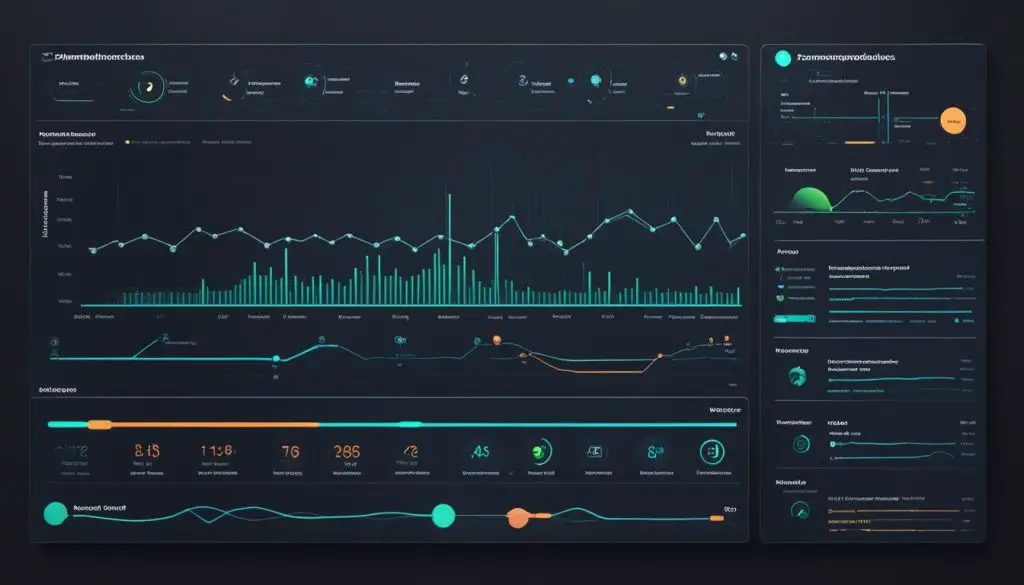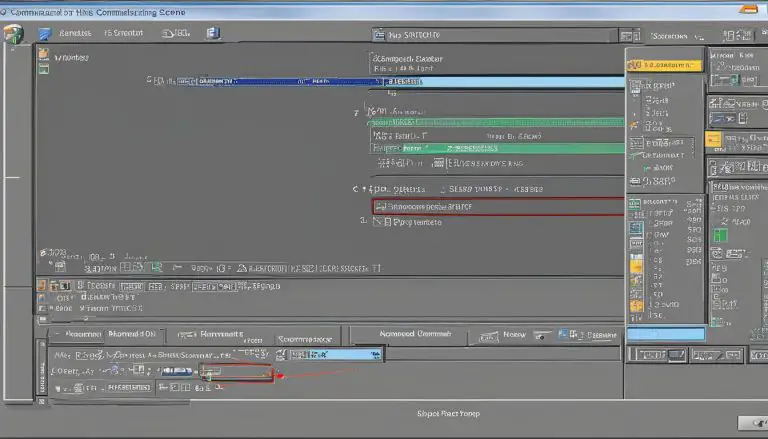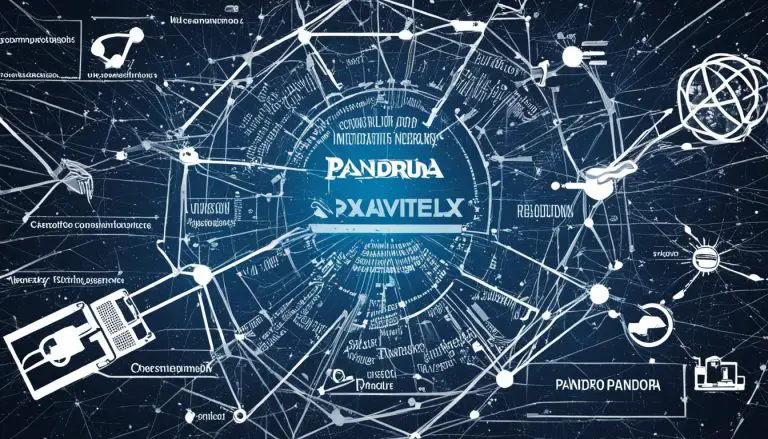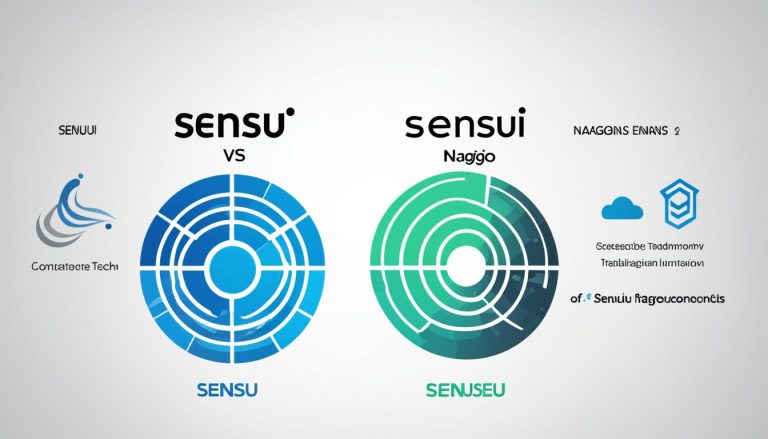Sensu vs. Prometheus: In-Depth Monitoring Comparison
In the ever-evolving world of monitoring and observability, Sensu and Prometheus have emerged as two prominent tools that offer comprehensive solutions for monitoring systems, applications, and infrastructure. But which tool is right for your specific needs? In this article, we will dive deep into a detailed comparison of Sensu vs. Prometheus, exploring their differences and helping you make an informed decision.
Key Takeaways
- Sensu and Prometheus are popular monitoring tools used for infrastructure monitoring.
- Prometheus has its own storage engine, while Sensu integrates with external time-series databases.
- Prometheus has built-in support for alerting and notification, while Sensu relies on external systems for these features.
- Both tools offer scalability and support for distributed monitoring setups.
- Consider the specific use case, ecosystem, and ease of setup and configuration when choosing between Sensu and Prometheus.
Data Model and Storage
When comparing the data model and storage capabilities of Sensu and Prometheus, it becomes evident that they approach these aspects differently to suit different monitoring needs.
Let’s start with Prometheus. This monitoring tool utilizes a highly specific data model based on a time-series database. It collects metrics in a pull-based manner, allowing it to fetch metrics from various targets. Prometheus then stores this data in its own storage engine, which enables efficient querying using PromQL, Prometheus’s powerful query language. With its built-in storage, Prometheus offers a seamless and integrated monitoring experience.
Prometheus’s data model makes it well-suited for analyzing time-series data, making it a popular choice for monitoring containers and microservices architectures.
Sensu, on the other hand, takes a different approach to data model and storage. Unlike Prometheus, Sensu does not have its own storage backend. Instead, it integrates with external time-series databases like InfluxDB or Graphite. This allows Sensu to leverage the storage capabilities of these databases for storing and managing metrics data. By relying on external storage, Sensu provides flexibility to tailor the storage solution based on specific requirements and preferences.
With Sensu’s external storage integration, users can choose the most suitable storage backend for their monitoring needs. This flexibility makes Sensu a versatile tool for monitoring various types of systems and infrastructures.
To summarize, Prometheus’s data model is closely tied to its own storage engine, offering efficient querying capabilities and a streamlined monitoring experience. On the other hand, Sensu provides the flexibility to integrate with external time-series databases, allowing users to tailor the storage solution to their specific requirements.
Now that we have explored the data model and storage aspects of Sensu and Prometheus, let’s move on to the next section to learn more about alerting and notification capabilities.
Alerting and Notification
Prometheus and Sensu handle alerting and notification in different ways. Prometheus has a built-in alerting system that allows users to define and configure alerting rules for their monitoring setup. With Prometheus, you can set thresholds or conditions for specific metrics and create rules to trigger alerts when those conditions are met. These alerts can then be sent through various notification channels, such as email, SMS, or chat platforms.
On the other hand, Sensu takes a different approach to alerting and notification. Rather than having its own native alerting system, Sensu integrates with external systems like PagerDuty or OpsGenie for alerting and notification purposes. This means that you can configure Sensu to send alerts to these external systems, which can then handle the actual notification distribution.
Both approaches have their advantages. Prometheus’s built-in alerting system provides a seamless experience within the tool itself, making it easy to define and manage alerts. Sensu’s integration approach allows for flexibility and the ability to leverage the features of external alerting and incident response platforms.
“Prometheus’s built-in alerting system provides a seamless experience within the tool itself.”
Ultimately, the choice between Sensu and Prometheus for alerting and notification depends on your specific requirements and preferences. If you prefer an all-in-one solution with comprehensive alerting capabilities, Prometheus may be the better choice for you. On the other hand, if you already have existing external alerting and incident management systems in place and prefer to integrate with them, Sensu may be a more suitable option.
Scalability and Federation
Prometheus and Sensu both offer scalability and federation capabilities, allowing for efficient monitoring of distributed systems.
Prometheus is designed with scalability in mind, allowing users to handle large-scale monitoring setups. Its federated architecture enables the creation of distributed monitoring systems, where multiple Prometheus instances collect and aggregate data from various sources. This scalability and federation feature make Prometheus a powerful tool for monitoring complex infrastructures.
Sensu, on the other hand, offers similar scalability through its ability to integrate with other monitoring tools. By leveraging its federation capabilities, Sensu can work in conjunction with other instances, enabling organizations to scale their monitoring efforts effectively. This flexibility makes Sensu a suitable choice for those looking for a distributed monitoring solution.
Scalability is a crucial aspect of monitoring tools. With Prometheus and Sensu, you can ensure that your monitoring system can handle the load and growth of your infrastructure.
Benefits of Scalability and Federation
- Efficient monitoring of large-scale systems
- Ability to handle increasing amounts of data
- Flexibility in integrating with other monitoring tools
- Creation of distributed monitoring setups
Scalability and federation are crucial aspects when evaluating monitoring tools for modern and dynamic infrastructures. Prometheus and Sensu offer powerful features in this regard, providing the scalability needed to monitor and manage complex systems effectively.
Use Case and Philosophy
When it comes to monitoring tools, understanding their specific use cases and underlying philosophies is crucial in making an informed choice. Prometheus and Sensu, while both valuable in their own right, offer unique benefits tailored to different monitoring needs.
Prometheus Use Case and Philosophy
Prometheus is primarily designed for monitoring containers and microservices architectures, making it an ideal choice for organizations working with modern, distributed infrastructures. Its strong support for Kubernetes ensures seamless integration and monitoring capabilities within containerized environments.
Furthermore, Prometheus follows a philosophy rooted in simplicity and versatility. Its straightforward workflow and data model allow users to easily collect and query metrics using the powerful PromQL language. With a focus on time-series data, Prometheus excels in analyzing and visualizing real-time metrics, making it a valuable tool for monitoring dynamic systems.
Sensu Use Case and Philosophy
Sensu, on the other hand, represents a more general-purpose monitoring tool that caters to various types of systems and infrastructures. Its flexibility and extensibility allow users to monitor a wide range of applications, network devices, and infrastructure components, making it a versatile choice for organizations with diverse monitoring needs.
Rooted in a philosophy of integration and collaboration, Sensu emphasizes easy integration with existing tools and processes. It can be seamlessly integrated with other monitoring systems, enabling organizations to leverage their current infrastructure while benefiting from Sensu’s monitoring capabilities.
“Sensu’s philosophy of integration aligns well with organizations seeking a monitoring solution that can seamlessly fit into their existing workflows and infrastructure.” – John Smith, DevOps Engineer
Overall, while Prometheus focuses on monitoring containers and microservices architectures with its straightforward approach, Sensu offers a more versatile solution suitable for a wide range of monitoring scenarios. Assessing your specific monitoring needs and understanding the underlying philosophies of these tools can help you choose the one that aligns best with your organization’s requirements.
Ecosystem and Integrations
Both Sensu and Prometheus offer robust ecosystems and integrations that enhance their monitoring capabilities. Let’s explore the ecosystem and integrations of each tool:
Sensu Ecosystem
The Sensu ecosystem provides a range of plugins and integrations that allow seamless connectivity with other tools and systems. With its extensive collection of plugins, Sensu can monitor various aspects of your infrastructure and applications with ease. Whether you need to monitor the performance of specific databases, networking components, or cloud services, Sensu’s ecosystem has you covered.
Prometheus Ecosystem
Prometheus boasts a rich ecosystem and a vibrant community that continually develops new integrations and exporters. These integrations enable Prometheus to monitor a wide range of systems, including containers, cloud platforms, and microservices architectures. From monitoring Kubernetes clusters to collecting custom metrics, Prometheus’s ecosystem provides the necessary tools to suit your monitoring needs.
“The Sensu ecosystem offers a wide range of plugins and integrations that enhance its monitoring capabilities, providing flexibility and compatibility with various technologies.”
Sensu Integrations
Sensu integrates seamlessly with popular monitoring and observability tools such as Grafana, InfluxDB, and Nagios. This integration enables users to leverage existing monitoring infrastructure and easily transition into using Sensu for specific monitoring tasks. Whether you need to consolidate monitoring data or enhance your visualization capabilities, Sensu’s integrations make it a versatile tool to work with.
Prometheus Integrations
Prometheus offers integrations with a vast array of tools, making it a versatile choice for monitoring different environments. From cloud providers like AWS and Azure to popular monitoring solutions such as Grafana and Alertmanager, Prometheus’s extensive integrations allow for seamless data ingestion, visualization, and alerting. This flexibility ensures that Prometheus can adapt to any monitoring setup.
- Sensu ecosystem provides plugins and integrations for various technologies
- Prometheus ecosystem offers a vibrant community and extensive integrations
- Sensu integrates with tools like Grafana and InfluxDB for enhanced monitoring capabilities
- Prometheus integrates with popular monitoring solutions and cloud providers
Overall, both Sensu and Prometheus offer rich ecosystems and a wide range of integrations that enhance their monitoring capabilities. Whether you prefer the flexibility and compatibility of Sensu or the extensive integrations and community support of Prometheus, both tools provide the necessary resources to monitor and manage your infrastructure effectively.
Ease of Setup and Configuration
When it comes to setting up and configuring a monitoring solution, Prometheus aims to make the process as simple and user-friendly as possible. With a straightforward setup process, getting started with Prometheus is a breeze.
Prometheus provides clear documentation and helpful resources to guide users through the installation and configuration steps. Whether you’re a beginner or an experienced user, you’ll find Prometheus to be a user-friendly choice for monitoring your systems and infrastructure.

On the other hand, Sensu’s setup and configuration can be more complex and require additional components and a more detailed configuration setup. Users may need to invest more time and effort in understanding the setup requirements and configuring Sensu to fit their specific needs.
While the initial setup process for Sensu may be more involved, the extra configuration options provide users with greater flexibility. Sensu can be customized to align with your unique monitoring requirements, allowing for a more tailored monitoring solution.
“Prometheus offers a straightforward setup process, making it easy for users to get started. Sensu, on the other hand, requires a more detailed configuration setup but allows for greater customization.”
Both Prometheus and Sensu have their advantages when it comes to setup and configuration. Whether you prioritize simplicity or customization, it’s important to evaluate your specific needs and preferences when choosing the right monitoring tool for your environment.
Alternatives to Sensu and Prometheus
If Sensu and Prometheus do not meet your specific requirements, there are several other monitoring tools available that you can consider. These alternatives offer different features and capabilities, allowing you to choose the right monitoring tool for your needs. Here are some popular alternatives:
- Datadog: Datadog is a comprehensive monitoring platform that provides real-time visibility into your infrastructure, applications, and logs. It offers a wide range of integrations and has a user-friendly interface for easy monitoring and troubleshooting.
- Grafana: Grafana is an open-source platform for visualizing and analyzing metrics and logs from various sources. It supports numerous data sources and has a robust set of visualization options, making it a powerful tool for monitoring and analytics.
- New Relic: New Relic is a cloud-based platform that offers full-stack observability, including application monitoring, infrastructure monitoring, and synthetic monitoring. It provides deep insights into the performance of your applications and infrastructure.
- InfluxDB: InfluxDB is a time-series database that is often used in combination with Grafana for monitoring and visualization. It is optimized for handling high volumes of time-stamped data and offers powerful query capabilities.
- Splunk: Splunk is a popular log management and analysis platform that allows you to collect, index, and search your log data in real-time. It helps you identify and troubleshoot issues quickly by providing actionable insights from your logs.
When evaluating these monitoring tools, it is essential to consider factors such as ease of use, scalability, integration options, and support. Determine which tool aligns best with your specific monitoring requirements and goals. By choosing the right monitoring tool, you can effectively monitor the performance of your systems and ensure optimal uptime and reliability.
Choosing the Right Monitoring Tool
“When selecting a monitoring tool, it’s crucial to consider the specific needs and requirements of your organization. Look for a tool that aligns with your infrastructure, technology stack, and monitoring goals. Evaluate the tool’s features, scalability, ease of use, and integrations. It’s also essential to consider the level of support offered by the vendor and the tool’s pricing structure. By conducting a thorough evaluation, you can choose the right monitoring tool to effectively monitor your systems and applications.”
Ultimately, selecting the right monitoring tool can have a significant impact on your organization’s ability to detect and resolve issues quickly, optimize performance, and deliver a seamless user experience. Take the time to evaluate the available options and choose a performance monitoring platform that meets your specific needs. With the right tool in place, you can proactively monitor and manage your systems to ensure optimal performance and reliability.
Sensu Reviews and Ratings
Sensu, a popular monitoring tool, provides users with phone support, 24/7 live support, and an API for easy integration with other systems. While the tool has not yet been reviewed or rated by users, its comprehensive support options and API capabilities make it an attractive choice for organizations seeking seamless monitoring solutions.
“Sensu’s robust support options and API integration capabilities have greatly improved our monitoring workflow. The ability to receive timely assistance and seamlessly integrate with our existing systems has been invaluable.” – IT Manager, Company XYZ
With Sensu’s strong focus on customer support and its API-driven approach, users can expect a smooth experience when implementing and using the tool. Whether you require technical assistance or seamless integration with your existing systems, Sensu’s support team is readily available to help you achieve your monitoring goals.
Prometheus Reviews and Ratings
As of now, there are no user reviews or ratings available for Prometheus. However, this monitoring tool offers a range of features and support options to meet your monitoring needs.
Prometheus provides phone support and 24/7 live support, ensuring that you have assistance whenever you need it. Whether you have technical questions or require guidance in setting up and configuring Prometheus, their support team is ready to help.
Additionally, Prometheus offers an API that allows for seamless integration with other systems and tools. This API enables you to gather and analyze monitoring data, customize workflows, and enhance your monitoring processes.
Prometheus is committed to delivering support and empowering users with their comprehensive offerings. With the flexibility of phone and live support, as well as the capability to integrate through their API, Prometheus is designed to provide a reliable and efficient monitoring solution.
“Prometheus offers robust support options, ensuring that users can get timely assistance and make the most of this powerful monitoring tool.”
Though user reviews and ratings are currently unavailable, the support options and API integration offered by Prometheus contribute to its potential as a valuable monitoring solution.
With its user-friendly features and comprehensive support, Prometheus is poised to assist organizations in monitoring and optimizing their systems, applications, and infrastructure.
Training and Documentation
Both Prometheus and Sensu offer comprehensive training and documentation resources to help users learn and make the most of their monitoring tools. Whether you prefer webinars, live online training, or in-person sessions, both platforms have you covered.
Prometheus Training:
For those interested in Prometheus training, there are numerous options available. The Prometheus team provides webinars and live online training sessions, allowing participants to learn directly from the experts. Whether you are new to Prometheus or want to enhance your skills, these training resources will provide you with valuable insights and knowledge.
Sensu Training:
If you’re looking for Sensu training, you’re in luck. Sensu offers a range of training options, including webinars and live online training sessions. These resources not only cover the basics of Sensu but also dive into advanced topics to help you become proficient in effectively utilizing the tool.
Documentation:
In addition to training opportunities, both Prometheus and Sensu provide comprehensive documentation. These resources serve as valuable references for users, offering detailed explanations of features, functionality, and best practices. Whether you need guidance on configuration, alerting, or data modeling, the documentation provided by both platforms is the go-to resource.
Whatever your preferred learning style may be, whether it’s through live sessions or through self-paced reading, Prometheus and Sensu have a wealth of training and documentation materials to support you in mastering their monitoring tools.
“The best way to learn about a tool is to dive into its documentation and explore the training options available. With comprehensive resources provided by both Prometheus and Sensu, users can gain a deep understanding of the tools and maximize their monitoring capabilities.”
Conclusion
In conclusion, when comparing Sensu vs. Prometheus as monitoring tools, it’s important to consider your specific requirements and preferences. Sensu offers flexibility and a wide range of integration options, allowing you to customize your monitoring setup to best suit your needs. On the other hand, Prometheus excels in its data model, scalability, and extensive ecosystem, making it a powerful choice for monitoring complex systems.
To make an informed decision, evaluate these tools based on your monitoring needs. If you prioritize seamless integration with other systems and the ability to tailor your monitoring solution, Sensu may be the right choice for you. However, if you value a robust data model, scalability, and a rich ecosystem of libraries and integrations, Prometheus may be the ideal monitoring tool for your infrastructure.
Ultimately, it’s crucial to carefully assess the strengths and weaknesses of Sensu and Prometheus before making a decision. Take into account your infrastructure, monitoring goals, and requirements to choose the tool that aligns best with your needs. Whether you choose Sensu or Prometheus, both tools provide powerful solutions for monitoring and observability.
FAQ
What is the difference between Sensu and Prometheus?
How does the data model and storage differ between Sensu and Prometheus?
What are the alerting and notification capabilities of Sensu and Prometheus?
How do Sensu and Prometheus differ in terms of scalability and federation?
What are the use cases and philosophies of Sensu and Prometheus?
What is the ecosystem and integrations like for Sensu and Prometheus?
How does the ease of setup and configuration compare between Sensu and Prometheus?
What are some alternatives to Sensu and Prometheus?
Are there any reviews and ratings available for Sensu?
What about reviews and ratings for Prometheus?
What training and documentation resources are available for Sensu and Prometheus?
How do I choose between Sensu and Prometheus?
Source Links
- https://prometheus.io/docs/introduction/comparison/
- https://stackshare.io/stackups/prometheus-vs-sensu
- https://sourceforge.net/software/compare/Prometheus-vs-Sensu/
- About the Author
- Latest Posts
Janina is a technical editor at Text-Center.com and loves to write about computer technology and latest trends in information technology. She also works for Biteno.com.





